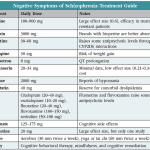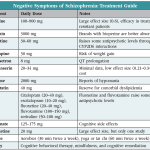Unraveling the Complexity of Schizophrenia: Understanding Positive, Negative, and Disorganized Symptoms
Imagine a world where reality is distorted, thoughts are jumbled, and emotions are out of control. This is the harsh reality for millions of people living with schizophrenia, a chronic and debilitating mental illness that affects approximately 1% of the global population. While there is still much to be learned about this condition, understanding its various symptoms can help us better support those affected and ultimately improve their quality of life.
Positive Symptoms: Hallucinations and Delusions
Schizophrenia’s positive symptoms are characterized by the presence of hallucinations and delusions. These experiences can be distressing and disorienting for individuals with schizophrenia, as they often have difficulty distinguishing between what is real and what is not.
The Hallmarks of Positive Symptoms
Positive symptoms typically manifest in one of two ways: auditory hallucinations or visual hallucinations. Auditory hallucinations can take the form of voices that are perceived as coming from outside the individual’s head, while visual hallucinations may involve seeing people or objects that are not actually present. Delusions, on the other hand, are fixed false beliefs that are resistant to reason and evidence.
For example, someone with schizophrenia might believe that they are being followed by government agents or that a specific person is trying to harm them. These delusions can lead to significant distress and disrupt daily functioning. It’s essential for healthcare providers and caregivers to recognize the presence of positive symptoms in individuals with schizophrenia and work towards developing effective treatment plans.
Negative Symptoms: Affecting Daily Life
While positive symptoms can be distressing, negative symptoms are often more debilitating and impact daily life. Negative symptoms refer to the loss or diminishment of normal emotional experiences, social engagement, and cognitive functioning.
The Hallmarks of Negative Symptoms
Negative symptoms typically include apathy, alogia (reduced speech), anhedonia (loss of pleasure), and flat affect (lack of emotional expression). These symptoms can make it challenging for individuals with schizophrenia to engage in activities they once enjoyed, leading to feelings of isolation and disconnection.
For instance, someone with negative symptoms might experience a lack of interest in hobbies or social activities that were previously enjoyable. They may also struggle to express emotions or show enthusiasm, which can impact their relationships and overall well-being.
It’s essential for healthcare providers and caregivers to recognize the presence of negative symptoms in individuals with schizophrenia, as they often require different treatment approaches than positive symptoms. By understanding these subtle yet significant changes, we can work towards developing personalized treatment plans that address both sets of symptoms.
According to the National Alliance on Mental Illness (NAMI), negative symptoms are just as important to treat as positive symptoms, and early intervention is crucial in improving outcomes for individuals with schizophrenia. [1]
Expert Consultation for Schizophrenia Symptoms
Get expert guidance on understanding and managing schizophrenia symptoms. Our medical professionals are here to help.
Schedule a consultationDisorganized Symptoms: Impaired Cognitive Function and Emotional Instability
In addition to positive symptoms, individuals with schizophrenia may also experience disorganized symptoms that impact their cognitive function and emotional stability.
The Consequences of Disorganization
Disorganized symptoms can manifest in various ways, including difficulties with planning, organization, and time management. This can lead to problems with daily functioning, such as forgetting appointments or struggling to complete tasks.
Emotionally, individuals with disorganized schizophrenia may experience mood swings, irritability, and emotional instability. They may also exhibit flat or blunted affect, making it challenging for others to read their emotions.
Summary of Schizophrenia Symptoms
In conclusion, schizophrenia symptoms can be categorized into three primary types: positive, negative, and disorganized. Positive symptoms include hallucinations and delusions, while negative symptoms involve the absence or reduction of normal emotional responses. Disorganized symptoms impact cognitive function and emotional stability.
Key Points
We have covered:
- Positive symptoms: hallucinations and delusions
- Negative symptoms: reduced or absent normal emotions
- Disorganized symptoms: impaired cognitive function and emotional instability
Final Insights
Understanding the complexities of schizophrenia symptoms is crucial for developing effective treatment plans. By recognizing the unique combination of positive, negative, and disorganized symptoms in each individual, healthcare providers can better support their patients and improve their overall quality of life.
A Call to Action: Empowering Support and Understanding
As we continue to unravel the mysteries of schizophrenia, it is essential that we prioritize empathy, understanding, and support for those affected. By working together, we can create a more compassionate and inclusive environment that fosters hope and healing. Let us join forces to break down the stigmas surrounding mental illness and pave the way for a brighter future – one where individuals with schizophrenia can thrive.
Frequent Urination: A Warning Sign of High Blood Sugar: Do you experience frequent urination, accompanied by other symptoms like thirst and fatigue? It may be more than just a minor issue. Learn how this common symptom can be an indicator of high blood sugar levels and what you can do to address it.
The Ultimate Guide to Intermittent Fasting for Women: Are you tired of feeling sluggish and out of shape? Intermittent fasting may be the key to unlocking your weight loss goals. Discover how this effective dieting method can benefit women, including tips on getting started, overcoming challenges, and achieving optimal health.




